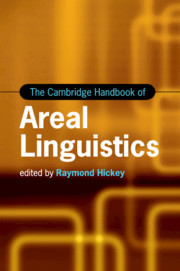Description
The Cambridge Handbook of Areal Linguistics
Cambridge Handbooks in Language and Linguistics Series
Coordinator: Hickey Raymond
A thoroughly informed look at the treatment of language contact and change in key areas across the world.
Language: English
Subject for The Cambridge Handbook of Areal Linguistics:
The Cambridge Handbook of Areal Linguistics
Publication date: 04-2020
Support: Print on demand
Publication date: 04-2020
Support: Print on demand
The Cambridge Handbook of Areal Linguistics
Publication date: 04-2017
1032 p. · 18.2x25.5 cm · Hardback
Publication date: 04-2017
1032 p. · 18.2x25.5 cm · Hardback
Description
/li>Contents
/li>Biography
/li>
Providing a contemporary and comprehensive look at the topical area of areal linguistics, this book looks systematically at different regions of the world whilst presenting a focussed and informed overview of the theory behind research into areal linguistics and language contact. The topicality of areal linguistics is thoroughly documented by a wealth of case studies from all major regions of the world and, with chapters from scholars with a broad spectrum of language expertise, it offers insights into the mechanisms of external language change. With no book currently like this on the market, The Cambridge Handbook of Areal Linguistics will be welcomed by students and scholars working on the history of language families, documentation and classification, and will help readers to understand the key area of areal linguistics within a broader linguistic context.
Preface; 1. Areas, areal features and areality Raymond Hickey; Part I. Issues in Areal Linguistics: 2. Why is it so hard to define a linguistic area? Lyle Campbell; 3. Areas and universals Balthasar Bickel; 4. Reassessing sprachbunds: a view from the Balkans Victor A. Friedman and Brian D. Joseph; 5. Areal sound patterns: from perceptual magnets to stone soup Juliette Blevins; 6. Convergence and divergence in the phonology of the languages of Europe Thomas Stolz and Nataliya Levkovych; 7. Word prominence and areal linguistics Harry van der Hulst, Rob Goedemans and Keren Rice; 8. Semantic patterns from an areal perspective Maria Koptjevskaja Tamm and Henrik Liljegren; Part II. Case Studies for Areal Linguistics: 9. The Germanic languages and areal linguistics Johan van der Auwera and Daniël Van Olmen; 10. Britain and Ireland Raymond Hickey; 11. Varieties of English Bernd Kortmann and Verena Schröter; 12. Slavic languages Alan Timberlake; 13. The Caucasus Sven Grawunder; 14. Western Asia Geoffrey Haig; 15. An areal view of Africa Bernd Heine and Anne-Maria Fehn; 16. Areal contact in Nilo-Saharan Gerrit Dimmendaal; 17. Niger-Congo languages Jeff Good; 18. The Kalahari Basin area as a 'sprachbund' before the Bantu expansion Tom Güldemann and Anne-Maria Fehn; 19. South Africa and areal linguistics Rajend Mesthrie; 20. Jharkhand as a 'linguistic area' John Peterson; 21. Sri Lanka and South India Umberto Ansaldo; 22. The Transeurasian languages Martine Robbeets; 23. The changing profile of case marking in the northeastern Siberia area Gregory D. S. Anderson; 24. Languages of China in their East and Southeast Asian context Hilary Chappell; 25. Language in the mainland Southeast Asia area N. J. Enfield; 26. Southeast Asian tone in areal perspective James Kirby and Marc Brunelle; 27. The areal linguistics of Australia Louisa Miceli and Alan Dench; 28. Languages of the New Guinea region Malcolm Ross; 29. Languages of Eastern Melanesia Paul Geraghty; 30. The Western Micronesian Sprachbund Anthony P. Grant; 31. Native North American languages Marianne Mithun; 32. The areal linguistics of Amazonia Patience Epps and Lev Michael; 33. Linguistic areas, linguistic convergence, and river systems in South America Pieter Muysken, Joshua Birchall, Rik van Gijn, Olga Krasnouhova and Neele Müller.
Raymond Hickey is Professor of English Linguistics at the University of Duisburg and Essen, Germany. His main research interests are varieties of English (especially Irish English and Dublin English) and general questions of language contact, variation and change. Among his recent book publications are Motives for Language Change (Cambridge, 2003), Legacies of Colonial English (Cambridge, 2004), Dublin English: Evolution and Change (2005), Irish English: History and Present-day Forms (Cambridge, 2007), The Handbook of Language Contact (2010), Eighteenth-Century English (Cambridge, 2010), Areal Features of the Anglophone World (2012) and The Sound Structure of Modern Irish (2014).
© 2024 LAVOISIER S.A.S.
These books may interest you

The Oxford Handbook of Polysynthesis 170.88 €



